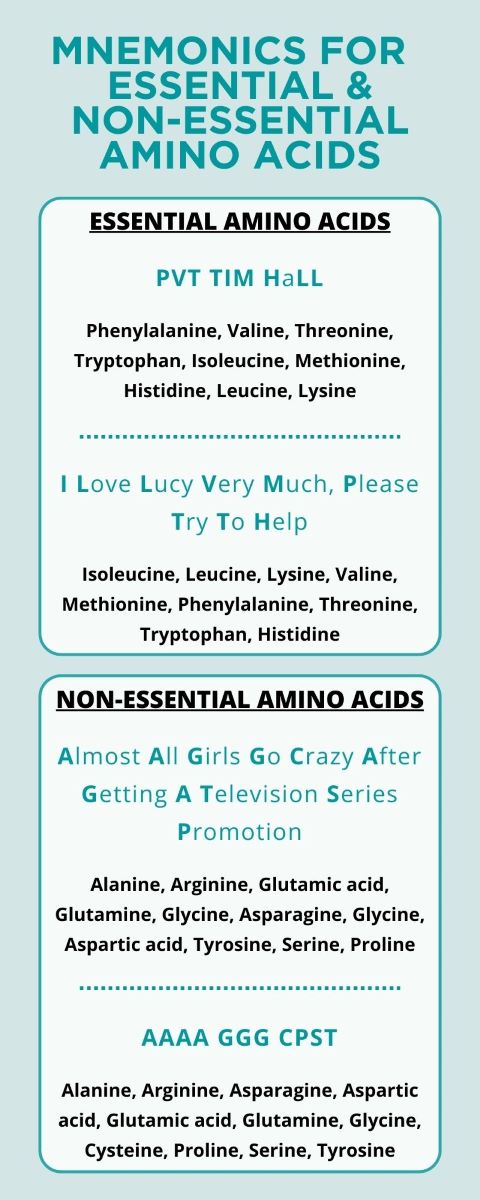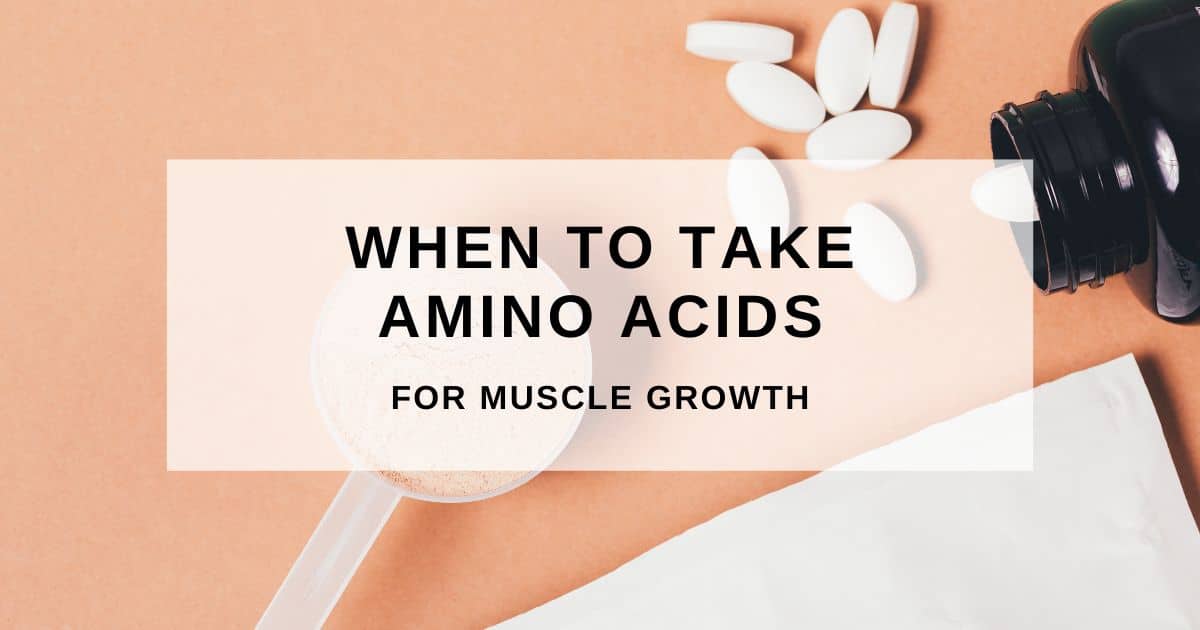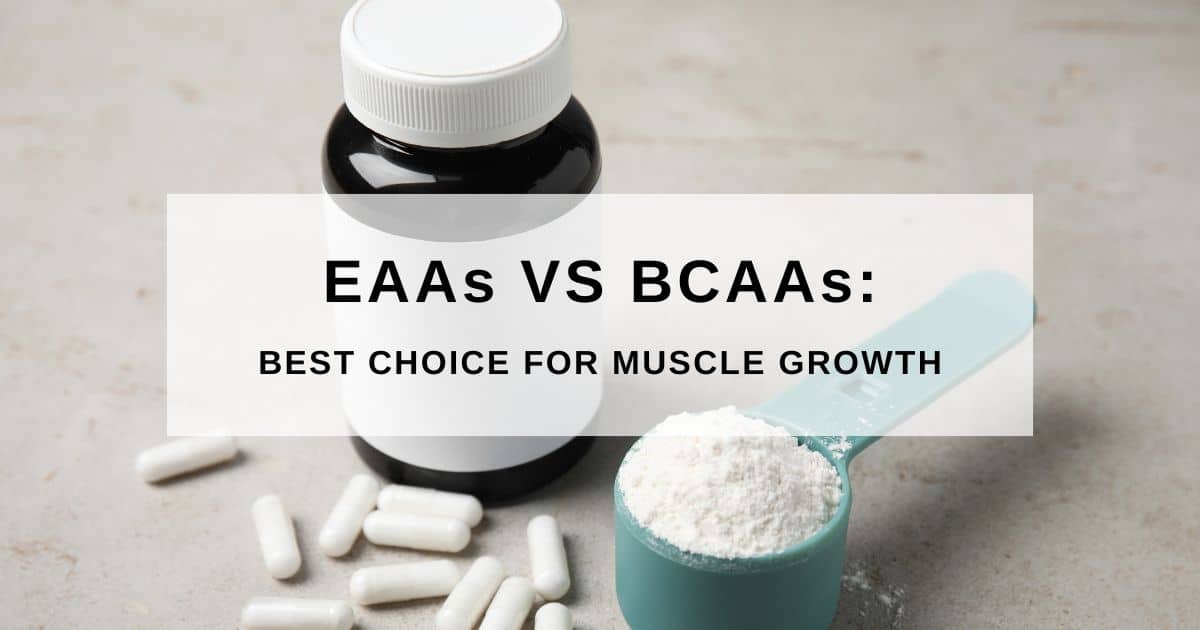Mnemonics are used as a study tool for memorizing terms and concepts. In this article, we hope you’ll find a helpful mnemonics for essential & nonessential amino acids. Some popular mnemonic devices include the following:
- Imagery and visualization: associating something you want to remember with a mental image
- Acronyms: creating a phrase using the first letter of terms you want to remember
- Rhymes: creating a rhyming phrase to remember concepts
- Chunking: breaking large pieces of information into smaller pieces
Because there are 20 amino acids, mnemonics can help with memorizing their names and categories while studying for various health, nutrition, and medical exams.
In this article, we’ll review the 20 proteinogenic amino acids (AAs) and popular mnemonics for essential amino acids (EAAs) and nonessential amino acids (NEAAs).
The essential & nonessential amino acids
These are the amino acids alphabetized and grouped into essential & nonessential categories:
- Essential amino acids: histidine, isoleucine, leucine, lysine, methionine, phenylalanine, threonine, tryptophan, and valine (2)
- Non-essential amino acids: alanine, arginine, asparagine, aspartic acid, cysteine, glutamic acid, glutamine, glycine, proline, serine, and tyrosine (2)
Essential amino acids mnemonics
Here are two mnemonics that use acronyms:
PVT TIM HaLL (“Private Tim Hall”)
- Phenylalanine, Valine, Threonine, Tryptophan, Isoleucine, Methionine, Histidine, Leucine, Lysine
I Love Lucy Very Much, Please Try To Help
- Isoleucine, Leucine, Lysine, Valine, Methionine, Phenylalanine, Threonine, Tryptophan, Histidine
Nonessential amino acids mnemonics
Here are two mnemonics using an acronym and chunking:
Almost All Girls Go Crazy After Getting A Television Series Promotion
- Alanine, Arginine, Glutamic acid, Glutamine, Cysteine, Asparagine, Glycine, Aspartic acid, Tyrosine, Serine, Proline
AAAA GGG CPST
- Alanine, Arginine, Asparagine, Aspartic acid, Glutamic acid, Glutamine, Glycine, Cysteine, Proline, Serine, Tyrosine
What are amino acids?
Amino acids are molecules mostly made of nitrogen, carbon, hydrogen, and oxygen that combine to form proteins. There are 20 proteinogenic amino acids, some of which the human body makes, while the rest need to be obtained from food.
Some functions of amino acids include breaking down food, repairing organs and tissues, making hormones and neurotransmitters, and providing energy (2, 3, 4).
Essential amino acids
Essential amino acids are the 9 amino acids that the human body either can’t make at all or doesn’t make enough of. In this case, we need to obtain EAAs from food sources. Some foods contain all 9 EAAs, like meat, fish, dairy, quinoa, soy, and buckwheat, while others only contain some of them, like beans, grains, nuts, and seeds (4).
Nonessential amino acids
The body makes non-essential amino acids in adequate amounts for most healthy people. This means that we don’t need to obtain them from our food except in circumstances where the body has an increased need for some of them (2).
Semi-essential amino acids
As briefly mentioned above, semi-essential amino acids (also called conditionally-essential amino acids) are amino acids that the body doesn’t make in adequate quantities or that are usually non-essential but become essential during times of illness and stress, like pregnancy, injury, surgery, and acute and chronic disease.
In these situations, the body’s need for some NEAAs is increased, so we need to get them from food or supplements (2).
The semi-essential amino acids include arginine, cysteine, glutamine, tyrosine, glycine, ornithine, proline, and serine (2).

Final Thoughts
Mnemonics can be very helpful for exam preparation, especially for memorizing the 20 amino acids and their categories. We hope this article was helpful for learning which AAs are considered essential, nonessential, and semi-essential and that using mnemonics for essential and non-essential amino acids will be helpful for your next exam!
If there is another mnemonic you use to keep the amino acids straight, please share in the comments for others to try!
Want to save this article? Click here to get a PDF copy delivered to your inbox.
This page may contain affiliate links. If you choose to purchase after clicking a link, we may receive a commission at no extra cost to you.
Collette is a registered dietitian and has over a decade of experience working with athletes, children & adults on tube feeding, and people with chronic health conditions. She has been writing about food and nutrition since she was in high school and has a passion for sharing evidence-based information, especially on the topics of protein and the importance of maintaining muscle mass for healthy aging.



